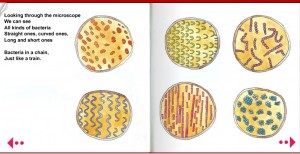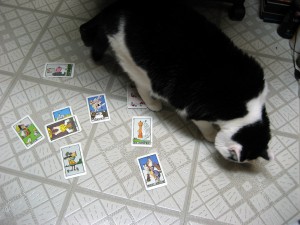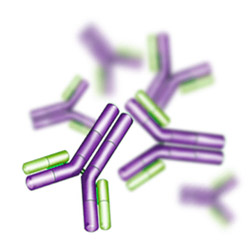If she were alive today, Ella Fitzgerald would have been 92. Sadly she is not, but her majestic singing will be with us for centuries to come. Oscar Peterson on the piano, Ray Brown bass and Ed Thigpen drums. A moving interpretation of Thelonious Monk`s ‘Round Midnight.
Short quiz and a movie for DNA day.
1) We celebrate DNA day because:
a) Congress said so
b) Francis Collins said so
c) I said so
2) Who has DNA?
a) CSI Miami
b) James Watson
c) Please, please, PLEASE let the paternity test comes back negative…
3) Nature vs. Nurture: which is more important?
a) Nature
b) Nurture
c) Nurture, but only if your mother was a hamster and your father smelled of elderberries
4) The following movie shows:
a) Replication
b) Application
c) Fumigation
Jonathan Eisen started something nice in his blog: a review of children’s science books. So I think I’ll follow suit, especially since my first review will combine two of Jonathan’s faves: Microbiology and Open Access. The book is “Bacteria Galore by Sunday at Four” by Mel Rosenberg, a Professor of Microbiology at Tel-Aviv University who wrote the text and Tali Niv-Dolinksy, the illustrator.
The book is Microbiology 101 for kids 3 and up. Rosenberg starts by gently disarming germophbias (if any) by showing how bacteria are basically all over the place, and how helpful they are in making some foods. Then he tells the story of their discovery, how fast they can divide to form colonies, and finally why we should brush our teeth, clean and dress wounds, and take our shots.
“You will always find bacteria in a pickle,
And in yoghurt too,
Making pickles and yoghurt tasty
Is part of what they do
And, if you please,
Bacteria help make yellow cheese.”
Rosenberg’s funny short rhymes make this book a perfect for beginning readers. Tali Niv-Dolinsky’s illustrations are woven impeccably into the text.
Best of all, the e-version is free, and you can even listen to Rosenberg read it (but you don’t have to, if you want to read it out loud to your favorite rugrat):
http://www.meltells.com/BacteriaGalore.asp
Unfortunately, I could not find the paper version in any of the Amazons, European or North American, and the Shop link on the site is still under construction. This page provides contact information for purchase.
And the future is certain Give us time to work it out -- Talking Heads - Road to Nowhere
We are a species obsessed with knowing what the future holds. Our personal future, the future of our kith and kin, our countries, and our planet.
Humans have always been trying to predict their personal future. Palms, stars, cards, dreams, knuckle-bones, coffee grounds, tea leaves, bird flight patterns, crystal balls and animal entrails have all been used (and many are still in use) for predicting the future. As we consider ourselves (industrialized nations) to have matured somewhat beyond this pish-posh, we have adopted so-called scientific methods for predicting future events. Even palmistry sounds better when advertised by Professor Mirza!
A common belief held by society is that parts of our personal future are, to borrow a Calvinistic term, predestined. Personal determinism is an underlying assumption that we encounter when we go looking for a job or enroll to a school. Psychometric tests and IQ tests claim to predict our ability to succeed at post secondary education. Aptitude and personality tests claim to predict our ability to perform at a certain job, how aggressive, innovative, timid, social or deviant we are. If we know the future, we can be prepared to deal with it, we may even be able to change it. From Oedipus Rex to Terminator III, human culture is imbibed with stories of those who, armed with the gift of prescience have changed a future and those who failed miserably, for better or worse. We are creatures of certain aptitudes, talents, and as yet undeveloped skills. The deterministic view has it that we can only hope to find out what they are, and develop them to the best of our ability. There may be some wriggle room within our assigned compartment, but it is still a compartment, and it is still assigned.
The future ain’t what it used to be
Recently, genomics emerged as a mechanism for a personal future prediction, or rather unveiling our ultimate personal determinism, but also giving us the ability to forestall or change certain outcomes that are supposedly branded in our genome. Since the advent of the human genome project, the popular media has been constantly bombarding us with such metaphors as: “the blueprint of life” and “unlocking our lives’ secrets”. We expect our genome to be read like the tapestry of life woven by the Norns: a document that, when properly read, can tell us our future. Which illnesses shall befall us, and when can we expect them? Would our unborn children be healthy? Intelligent? Musical? Delinquent?
In the latter epoch of those 2 billion-odd years between non-life and life on early Earth, our ancestral molecular replicators were quite probably RNA, not DNA. There are many arguments for this RNA world hypothesis: RNA can store information in its sequence, and self -duplicate; it can also catalyze reactions as a ribozyme. So technically, RNA has all the facilities necessary to be a replicator. Not only that, RNA can catalyze the formation of peptide bonds, providing a plausible link between the RNA world and the protein world we live in today. One strong supporting evidence for the RNA world is the ribosome: the ubiquitous ribozyme / protein complex that translates messenger RNA to proteins. The ribosome is mostly composed of RNA, it exists in all three super-kingdoms of life, and is conserved within the super-kingdoms. But the ribosome is a very complex machine: can we find one of the ribosome’s less complex precursors? One that post-dates the RNA-only world, but not quite as complex and specific as today’s ribosome?
Isabella Moll’s group at the Max F. Perutz Laboratories (MFPL) in Vienna may have just discovered a candidate for an ancestral ribosome. In bacteria, messenger RNA or mRNA has a 5` untranslated region, that commonly includes the Shine-Dalgarno sequence: a six nucelotide consensus sequence AGGAGG located just before the AUG codon, which marks the translation start site. However some mRNA molecules lack a Shine- Dalgarno, yet still get translated. Moll’s group were looking at such leaderless messenger RNA, or lmRNA. lmRNA might be a remnant dating back to a more primitive era of translation, where the Shine Dalgarno motif has not yet evolved.
Moll’s group were using kasugamycin, an antibiotic that blocks transcription, to inhibit the translation of mRNA. While the translation of mRNA containing Shine-Dalgarno sequences was inhibited by kasugamycin, translation of lmRNA was not inhibited. When they examined the ribosomal particles that were translating lmRNA despite the presence of kasugamycin, they found their molecular weight to be lighter: 61S instead of the usual 70S in bacteria. The ribosome is a complex piece of molecular machinery, consisting of many RNA and protein components. Nevertheless, Moll’s group has shown that the smaller ribosome, lacking in many parts, can still translate lmRNA, but not leadered (Shine-Dalgarno containing) RNA. This “bare-bones” ribosome may very well be a version of the proto-ribosome, dating back to the dawn of life, before the separation of life’s superkingdoms.
Kaberdina, A., Szaflarski, W., Nierhaus, K., & Moll, I. (2009). An Unexpected Type of Ribosomes Induced by Kasugamycin: A Look into Ancestral Times of Protein Synthesis? Molecular Cell, 33 (2), 227-236 DOI: 10.1016/j.molcel.2008.12.014
We learned in high school and/or undergrad biology that one antibody would bind to one antigen. This is what makes our immune system so effective: antibodies bind with high affinity to foreign proteins or other molecules. Not only that, but those antibodies are specific: they would bind only to a specific site on the foreign protein (epitope) and fitting in it like a key in a lock. They business end of the key (antibody) is called the paratope.
A group at Genentech designed an antibody whose paratope binds two completely different targets. Human epidermal growth factor 2 (HER2) and Vascular Endothelial Growth Factor (VEGF). Both proteins are cancer therapy targets, and both are targets of antibody therapy of two different engineered antibodies. Jenny Bostrom and her colleagues at Genentech have designed one antibody that binds both proteins. They used a phage display library starting from a HER2- binding antibody, and screened for an antibody that maintained HER2 binding, but in addition bound VEGF. Both proteins were bound with a high affinity. They actually bind competitively to the binding site, so the antibody cannot bind both VEGF and HER2, only one or the other.
Why bother doing that if we already have two antibodies, each binding its target epitope with a hight affinity? For therapeutic purposes, it is better to dose with one antibody than with a combination therapy. Combination therapies can be expensive, and their outcomes are unclear; sometimes the clinical outcome could be worse.
One interesting question this study raises is an evolutionary one. Could such antibodies exist naturally? Could we have evolved antibodies that bind two completely different epitopes? When we use antibodies in the lab, we tend to screen against those that are promiscuous: bind more than one epitope. But maybe such antibodies do exist? I’ll admit I am less than well-versed in immunology, so anyone who knows anything about this is welcome to comment. Would such antibodies increase their organsm’s fitness? We do know that one line of the body’s defence against against cancer is immunological, so could we have a mechanism generating such “two-for-one” antibodies against cancer, or pathogens?
Bostrom, J., Yu, S., Kan, D., Appleton, B., Lee, C., Billeci, K., Man, W., Peale, F., Ross, S., Wiesmann, C., & Fuh, G. (2009). Variants of the Antibody Herceptin That Interact with HER2 and VEGF at the Antigen Binding Site Science, 323 (5921), 1610-1614 DOI: 10.1126/science.1165480
Wordle is a toy for creating word clouds from text. Each word’s size is correlated with its frequency in the input text. Every three months or so I will generate a Wordle from the RSS feed of this blog, to see whether this blog has any direction, theme change, and just because Wordles are cool. Click on image for full size.
…Your Brain Will Fall Out.
Apparently sequencing two white males of European extraction does not make for a very good sample of mankind, and that if we really want to get a good view of what we are really like, we need to sequence a couple more. Maybe even, you know, a woman, or someone from India or China or Egypt or Brazil… just a thought.
Until sequencing becomes cheap enough to get the full genome of every Tom Dick & Harriet, the technique of choice would be to (1) sequence as many genomic bits and pieces as we can ; (2) map them to a reference genome and (3) make the sequence information and metadata globally available. The first part is being done all the time: every time future parents go for a genetic testing, every time a genetic or a cancer is diagnosed (or negatively diagnosed), every time 23andme hold a spit party and of course, every time Horatio Caine takes off his sunglasses and says in that terse controlled voice: “Well Miss Boa Vista, what have you got for me?” — every time one of those happens, yet another variation of part of the human genome has been sequenced. Or rather “humanity’s genome”.
(Uh… y’all do know Horatio Caine is a fictional character… OK, good. Let’s move on).
Cue the Human Variome Project (HVP). A large international effort that aims to consolidate all these genomic data and associated metadata. A list of the HVPs goals as outlined in the most recent meeting report paper:
Continue reading The Human Genome Variome Project and Google News Reader →
Drive by Truckers. My favorite flavor of Southern Rock.
Following Shirley Wu’s excellent post on the stimulus money at the NIH, I decided to do my bit, and post some bioinformatically relevant programs from the Challenge Grants. I am defining bioinformatics rather narrowly here, and excluding most biomedical informatics, imaging technologies, clinical data management, etc. Also, many other topics would be supported to some extent with bioinformatics. I picked those that seem to have bioinformatics as the core applicable field.
Continue reading NIH Stimulus money: what is in it for Bioinformatics? →
Hypatia (b. ~360CE d. 415CE) was a mathematician, philosopher, astronomer and teacher in Roman Alexandria. She was also quite probably the last librarian of the famous Library of Alexandria. Note that at the time, the definition of Philosophy was much broader, and encompassed what we term today the natural and exact sciences; and yes, she was also a techie. She is credited with inventing the hydrometer, for measuring the specific gravity of liquids.
In a time of political turmoil, she appeared to have supported the secular authority Prefect of Rome, Oresteus against the Pope of Alexandria, Cyril. Eventually, this cost her her life. Socrates Scholasticus (Socrates of Constantinople), a 5th Century Christian Church Historian wrote in Historia Ecclesiastica:
Chapter XV.–Of Hypatia the Female Philosopher.
There was a woman at Alexandria named Hypatia, daughter of the
philosopher Theon, who made such attainments in literature and science,
as to far surpass all the philosophers of her own time. Having
succeeded to the school of Plato and Plotinus, she explained the
principles of philosophy to her auditors, many of whom came from a
distance to receive her instructions. On account of the self-possession
and ease of manner, which she had acquired in consequence of the
cultivation of her mind, she not unfrequently appeared in public in
presence of the magistrates. Neither did she feel abashed in coming to
an assembly of men. For all men on account of her extraordinary dignity
and virtue admired her the more. Yet even she fell a victim to the
political jealousy which at that time prevailed. For as she had
frequent interviews with Orestes, it was calumniously reported among
the Christian populace, that it was she who prevented Orestes from
being reconciled to the bishop. Some of them therefore, hurried away by
a fierce and bigoted zeal, whose ringleader was a reader named Peter,
waylaid her returning home, and dragging her from her carriage, they
took her to the church called Caesareum, where they completely stripped
her, and then murdered her with tiles. After tearing her body in
pieces, they took her mangled limbs to a place called Cinaron, and
there burnt them. This affair brought not the least opprobrium, not
only upon Cyril, but also upon the whole Alexandrian church. And
surely nothing can be farther from the spirit of Christianity than the
allowance of massacres, fights, and transactions of that sort. This
happened in the month of March during Lent, in the fourth year of
Cyril’s episcopate, under the tenth consulate of Honorius, and the
sixth of Theodosius.
Ian Holmes introduced me to Ada Lovelace day. I pledged to blog this day, and here we are. Hypatia was an intelligent, courageous, free-thinking woman who paid dearly for her beliefs, her principles, and if you can read between the lines, her gender.
Beautiful and sad. Extra points if you recognize the source of the sentence Lisa reads at the end.






























